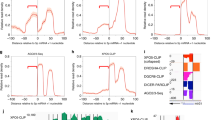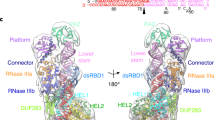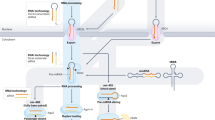Abstract
Mature microRNAs (miRNAs) are generated via a two-step processing pathway to yield ∼22-nucleotide small RNAs that regulate gene expression at the post-transcriptional level1. Initial cleavage is catalysed by Drosha, a nuclease of the RNase III family, which acts on primary miRNA transcripts (pri-miRNAs) in the nucleus2. Here we show that Drosha exists in a multiprotein complex, the Microprocessor, and begin the process of deconstructing that complex into its constituent components. Along with Drosha, the Microprocessor also contains Pasha (partner of Drosha), a double-stranded RNA binding protein. Suppression of Pasha expression in Drosophila cells or Caenorhabditis elegans interferes with pri-miRNA processing, leading to an accumulation of pri-miRNAs and a reduction in mature miRNAs. Finally, depletion or mutation of pash-1 in C. elegans causes de-repression of a let-7 reporter and the appearance of phenotypic defects overlapping those observed upon examination of worms with lesions in Dicer (dcr-1) or Drosha (drsh-1). Considered together, these results indicate a role for Pasha in miRNA maturation and miRNA-mediated gene regulation.
This is a preview of subscription content, access via your institution
Access options
Subscribe to this journal
Receive 51 print issues and online access
$199.00 per year
only $3.90 per issue
Buy this article
- Purchase on SpringerLink
- Instant access to full article PDF
Prices may be subject to local taxes which are calculated during checkout




Similar content being viewed by others
References
Lee, Y., Jeon, K., Lee, J. T., Kim, S. & Kim, V. N. MicroRNA maturation: stepwise processing and subcellular localization. EMBO J. 21, 4663–4670 (2002)
Lee, Y. et al. The nuclear RNase III Drosha initiates microRNA processing. Nature 425, 415–419 (2003)
Carrington, J. C. & Ambros, V. Role of microRNAs in plant and animal development. Science 301, 336–338 (2003)
Yi, R., Qin, Y., Macara, I. G. & Cullen, B. R. Exportin-5 mediates the nuclear export of pre-microRNAs and short hairpin RNAs. Genes Dev. 17, 3011–3016 (2003)
Lund, E., Guttinger, S., Calado, A., Dahlberg, J. E. & Kutay, U. Nuclear export of microRNA precursors. Science 303, 95–98 (2004)
Bohnsack, M. T., Czaplinski, K. & Gorlich, D. Exportin-5 is a RanGTP-dependent dsRNA-binding protein that mediates nuclear export of pre-miRNAs. RNA 10, 185–191 (2004)
Hutvagner, G. et al. A cellular function for the RNA-interference enzyme Dicer in the maturation of the let-7 small temporal RNA. Science 293, 834–838 (2001)
Grishok, A. et al. Genes and mechanisms related to RNA interference regulate expression of the small temporal RNAs that control C. elegans developmental timing. Cell 106, 23–34 (2001)
Ketting, R. F. et al. Dicer functions in RNA interference and in synthesis of small RNA involved in developmental timing in C. elegans. Genes Dev. 15, 2654–2659 (2001)
Song, J. J. et al. The crystal structure of the Argonaute2 PAZ domain reveals an RNA binding motif in RNAi effector complexes. Nature Struct. Biol. 10, 1026–1032 (2003)
Zhang, H., Kolb, F. A., Jaskiewicz, L., Westhof, E. & Filipowicz, W. Single processing center models for human Dicer and bacterial RNase III. Cell 118, 57–68 (2004)
Siolas, D. et al. Synthetic shRNAs as highly potent RNAi triggers. Nature Biotechnol. (submitted)
Schwarz, D. S. et al. Asymmetry in the assembly of the RNAi enzyme complex. Cell 115, 199–208 (2003)
Llave, C., Xie, Z., Kasschau, K. D. & Carrington, J. C. Cleavage of Scarecrow-like mRNA targets directed by a class of Arabidopsis miRNA. Science 297, 2053–2056 (2002)
Yekta, S., Shih, I. H. & Bartel, D. P. MicroRNA-directed cleavage of HOXB8 mRNA. Science 304, 594–596 (2004)
Olsen, P. H. & Ambros, V. The lin-4 regulatory RNA controls developmental timing in Caenorhabditis elegans by blocking LIN-14 protein synthesis after the initiation of translation. Dev. Biol. 216, 671–680 (1999)
Zeng, Y., Wagner, E. J. & Cullen, B. R. Both natural and designed micro RNAs can inhibit the expression of cognate mRNAs when expressed in human cells. Mol. Cell 9, 1327–1333 (2002)
Doench, J. G., Petersen, C. P. & Sharp, P. A. siRNAs can function as miRNAs. Genes Dev. 17, 438–442 (2003)
Wu, H., Xu, H., Miraglia, L. J. & Crooke, S. T. Human RNase III is a 160-kDa protein involved in preribosomal RNA processing. J. Biol. Chem. 275, 36957–36965 (2000)
Bernstein, E., Caudy, A. A., Hammond, S. M. & Hannon, G. J. Role for a bidentate ribonuclease in the initiation step of RNA interference. Nature 409, 363–366 (2001)
Giot, L. et al. A protein interaction map of Drosophila melanogaster. Science 302, 1727–1736 (2003)
Shiohama, A., Sasaki, T., Noda, S., Minoshima, S. & Shimizu, N. Molecular cloning and expression analysis of a novel gene DGCR8 located in the DiGeorge syndrome chromosomal region. Biochem. Biophys. Res. Commun. 304, 184–190 (2003)
Reinhart, B. J. et al. The 21-nucleotide let-7 RNA regulates developmental timing in Caenorhabditis elegans. Nature 403, 901–906 (2000)
Caudy, A. A. et al. A micrococcal nuclease homologue in RNAi effector complexes. Nature 425, 411–414 (2003)
Gregory, R. I. et al. The Microprocessor complex mediates the genesis of microRNAs. Nature doi:10.1038/nature03120 (this issue)
Han, M. H., Goud, S., Song, L. & Fedoroff, N. The Arabidopsis double-stranded RNA-binding protein HYL1 plays a role in microRNA-mediated gene regulation. Proc. Natl Acad. Sci. USA 101, 1093–1098 (2004)
Liu, Q. et al. R2D2, a bridge between the initiation and effector steps of the Drosophila RNAi pathway. Science 301, 1921–1925 (2003)
Tabara, H., Yigit, E., Siomi, H. & Mello, C. C. The dsRNA binding protein RDE-4 interacts with RDE-1, DCR-1, and a DExH-box helicase to direct RNAi in C. elegans. Cell 109, 861–871 (2002)
Caudy, A. A., Myers, M., Hannon, G. J. & Hammond, S. M. Fragile X-related protein and VIG associate with the RNA interference machinery. Genes Dev. 16, 2491–2496 (2002)
Spector, D. L. & Smith, H. C. Redistribution of U-snRNPs during mitosis. Exp. Cell Res. 163, 87–94 (1986)
Acknowledgements
We thank F. Rivas for critical reading of the manuscript. Strain BC3825 was obtained from the C. elegans Genetics Center, and drsh-1(tm0654) was obtained from the NBP in Japan (Mitani laboratory). We thank E. Cuppen and his group for help in target-selected mutagenesis. A.M.D. is a David Koch Fellow of the Watson School of Biological Sciences. G.J.H. is supported by an Innovator Award from the US Army Breast Cancer Research Program. This work was also supported by a grant from the NIH (G.J.H.) and by a VENI fellowship from the Netherlands Organisation for Scientific Research (R.F.K.).
Author information
Authors and Affiliations
Corresponding author
Ethics declarations
Competing interests
The authors declare that they have no competing financial interests.
Supplementary information
Rights and permissions
About this article
Cite this article
Denli, A., Tops, B., Plasterk, R. et al. Processing of primary microRNAs by the Microprocessor complex. Nature 432, 231–235 (2004). https://doi.org/10.1038/nature03049
Received:
Accepted:
Published:
Issue Date:
DOI: https://doi.org/10.1038/nature03049



